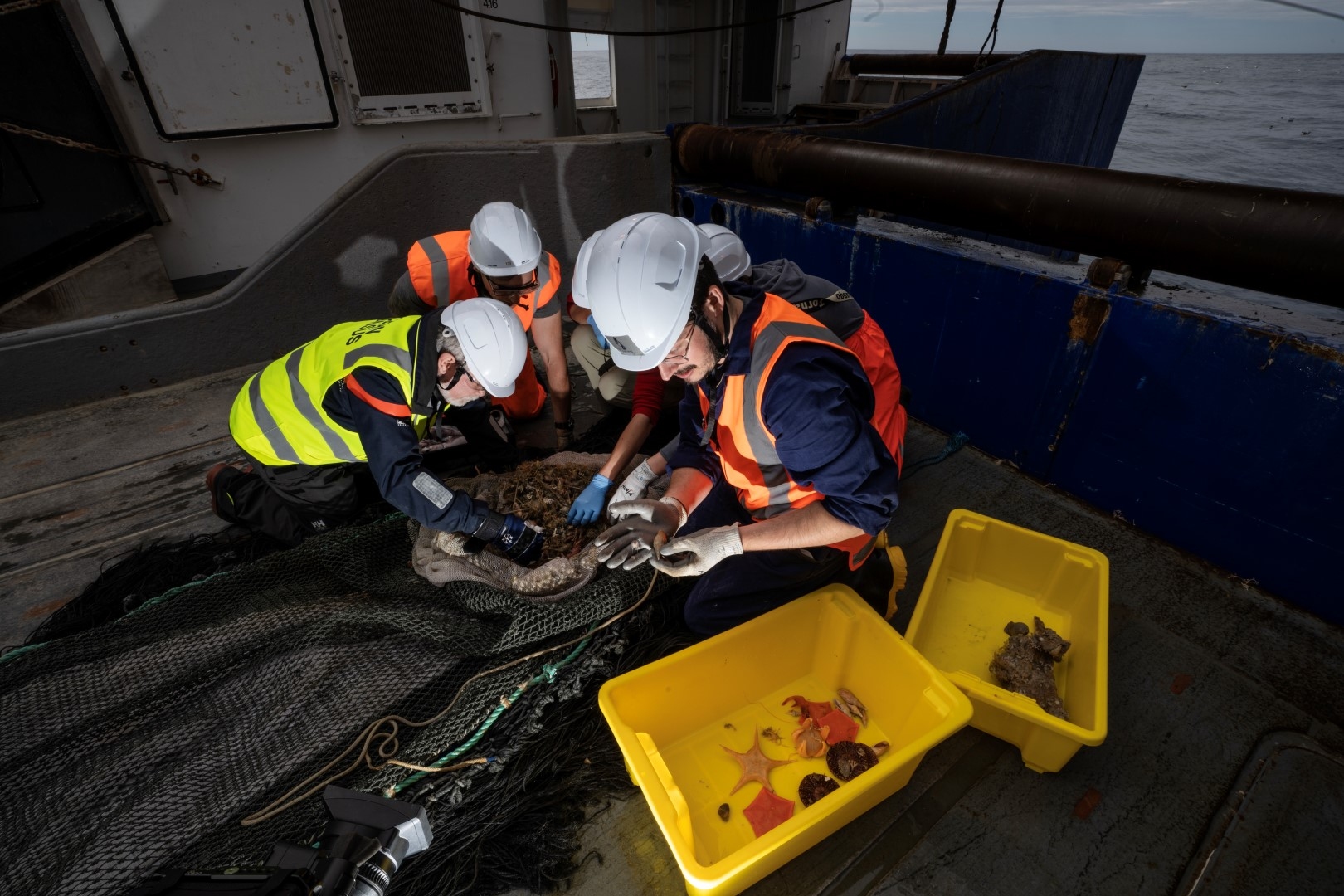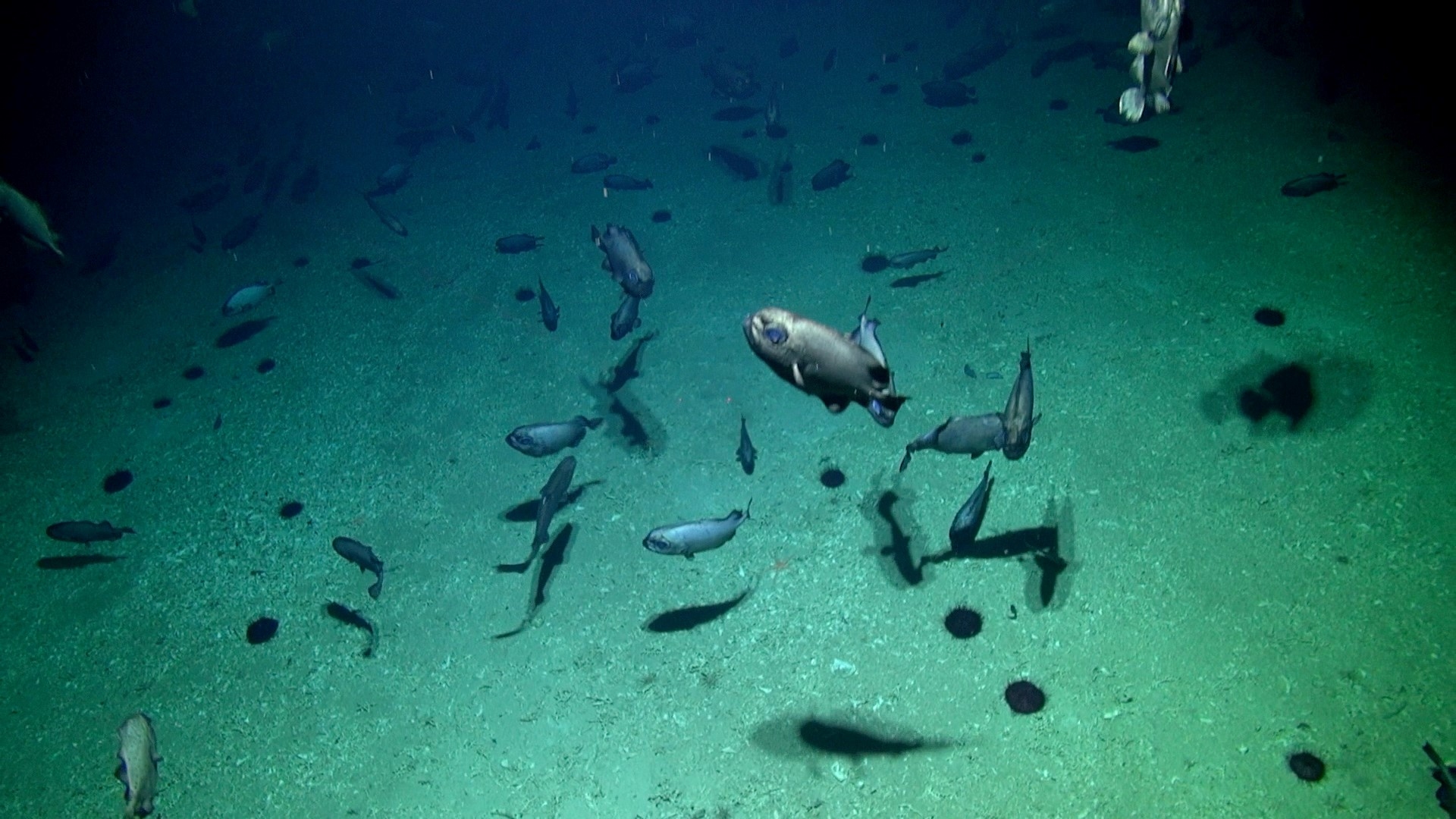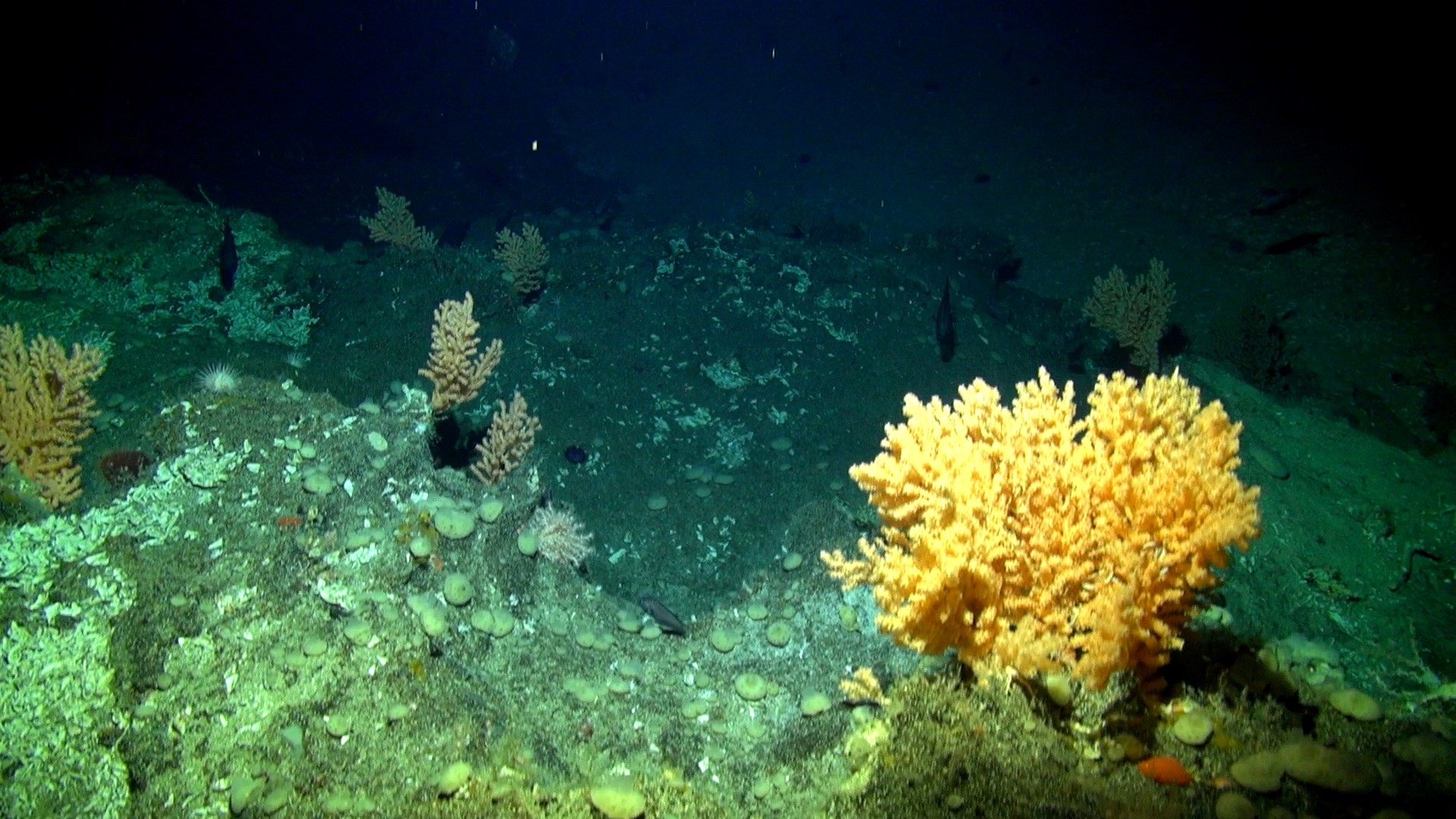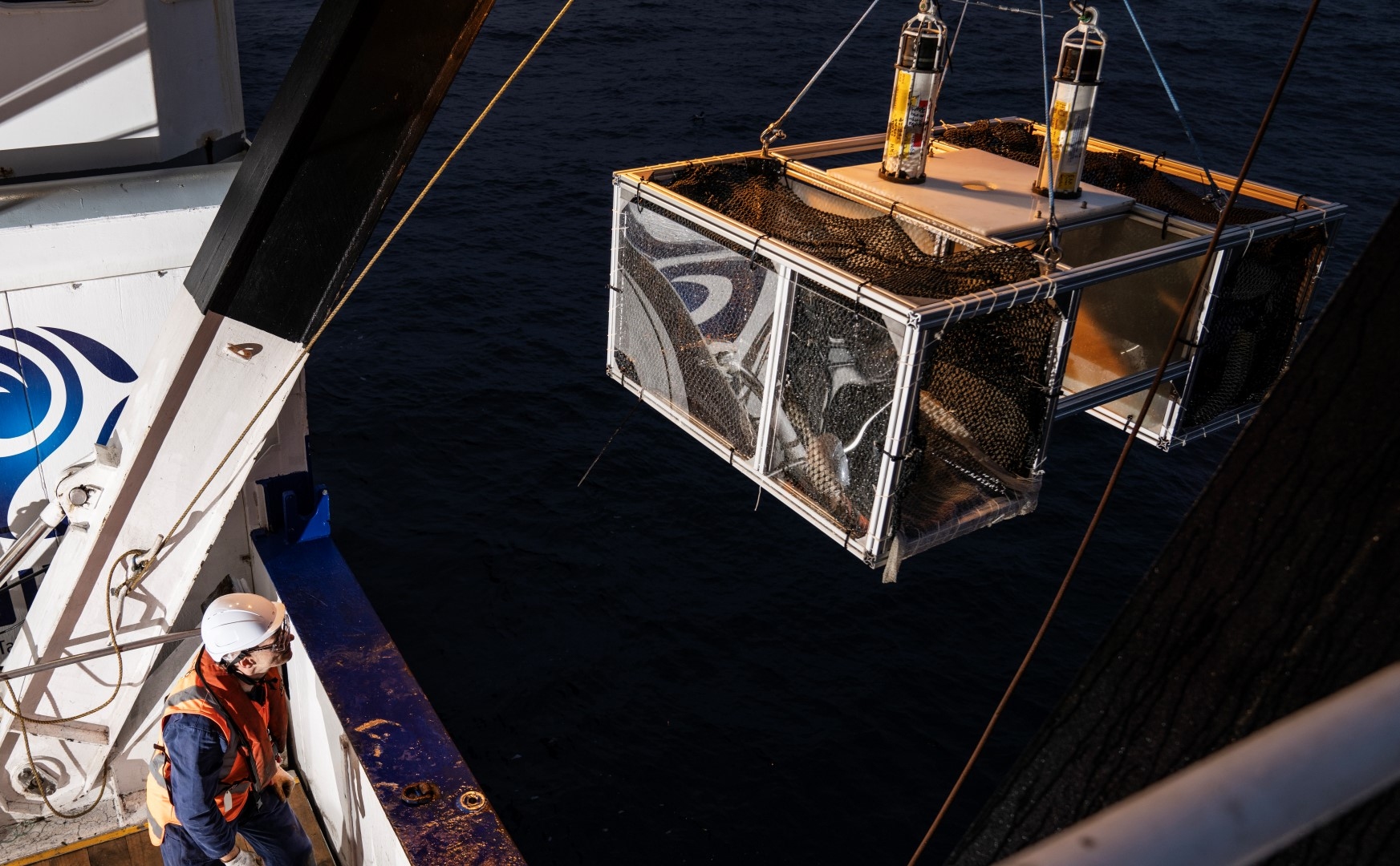Bounty Trough - voyage update #2
Greetings from the Bounty Trough!
If I had to sum up our progress in a word: Life. And lots of it! At the end of Tuesday, we had preserved 400 samples (a mix of single specimens and multiple specimens per lot) – and that number is only increasing. As I write this, it will be out of date already.
Amongst that number are holothurians, sponges, black corals, octopus, rat-tail fish and an eelpout, sea spiders, three possible new species of snails and sea slugs, and much, much, more. We talk a lot about larger specimens, e.g. our first cephalopod specimen and a deep-sea Vulcanoctopus. But a lot of the samples we are collecting that are only visible with a microscope, such as nematode worms that live in between the sand grains on the seafloor, and we won’t hear about those until the workshop onshore.
We are interested in animal life from two main categories: marine invertebrates (for NIWA and Te Papa’s invertebrate collections) and marine vertebrates (for Te Papa’s New Zealand’s national reference collection of fishes: the National Fish Collection). Some are large, like fish, corals and sponges; Some are very small; like sea slaters, sand hoppers, snails and worms that live in the sediment on the seafloor. The recent New Zealand Marine Biota NIWA Biodiversity Memoir outlines just how many species are known and yet we have so many more to discover.
This update describes days exploring the diverse life around the continental slope and canyons off the Otago coast, including on seamounts and near pockmarks over Sunday 11 February and Monday, 12 February. This is not too far off New Zealand (about 22.6 km). Then we head out to our first transect site along the Bounty channel, 975km off the South Island to explore depths beyond 1500m and toward 5000m. Images in this update are thanks to our videographer aboard, Rebekah Parsons-King.

Seamounts (Sunday)
Over Sunday we visited two undersea mountains (seamounts). over a thousand seamounts, knolls, and hills lay beneath the waters around New Zealand. They are often sites of flourishing sea life, with spectacular reefs of cold-water corals and large sponges, and have become the focus of important commercial fisheries for such deepwater species as orange roughy, oreos, black cardinalfish, and alfonsino. Seamounts are hotspots of diversity that enable animals to live and feed on the rich upwelling food supply at much shallower depths than the surrounding abyssal plains of the deep ocean.

When the weather improved enough, we were able to get our “eyes” (via our DTIS – Deep Towed Imaging System) on seamount 5. DTIS is basically a sophisticated underwater camera. It is vital to our work and allows us to investigate an area before we deploy any sampling gear. We deployed DTIS on the main hill at 620 m deep and then we ran down the flank of the seamount. When looked at the monitor onboard, we saw tam'o'shanter sea urchins and chimera (ghost sharks), dead coral rubble substrate with encrusting fauna, rattails and sharks. This got everyone excited!
Once we knew what was down there, we deployed a range of our equipment to retrieve samples from the seafloor. One of the pieces of equipment we used was NIWA’s “Seamount” epibenthic sled, which is 1.5 m long, by 1.0 m wide, and has a vertical opening of 0.5 m. It is towed at 1-1.5 knots and can be used on sloped, somewhat rugged, hard rocky seafloor. The deployment of this was very successful with a number of samples brought aboard including rocks encrusted with anemones.
But if Seamount 5 was impressive, we were in for a shock when we headed to Seamount 4. As Co-lead Alex Rogers put it, “Filming on Seamount 4 by DTIS was quite remarkable. This was an isolated and small feature <200m in elevation. However, the seamount proved to be a rugged outcropping of bedrock with abundant black oreo (Allocytus niger), occasional orange roughy and other fish and shark species. The seamount substratum also consisted of coral rubble, but rock faces were colonised by dense populations of yellow sponges and in places large orange colonies of primnoid corals were also visible.”

A single deployment with the seamount sled successfully recovered good examples of the fauna observed.
These two are just two of the several seamounts on our voyage. They are quite remarkable features of our seabed. As my colleague Ashley Rowden says, “The animals that live on seamounts can be very different to those on the surrounding seafloor. Some of the animals found on seamounts can be very rare and, in certain cases, only found on that particular seamount. Scientists have even found animals on seamounts that we thought became extinct millions of years ago.”
Final pockmark site and out along the channel (Monday)
In the early hours of Monday morning (12 February) we transited to our second and final pockmark site (PM2) on the Otago shelf margin. This is another area where we suspected there might have been seep communities and a lot of our team had their hunches (or wishes) about what might be down there. We deployed the fish trap lander and then started a DTIS transect across pockmark features on flat soft sediments, heading southwest. Three multicore deployments collected 5 cores of mud, so our teams were very happy to collect samples from these. The multicorer collects seafloor sediment samples across the sediment-water interface. It can deploy up to eight barrels of 9.5-cm diameter. The core barrels are triggered to collect sediment when they reach the seafloor. A single deployment of the multi-corer results in multiple sediment samples, which will be used to measure sediment characteristics, and collect infaunal (macrofaunal and meiofaunal) samples which we will fully investigate later.

The ”Brenke” sled was deployed here as well and retrieved good samples. While the corer grabs samples from life within the seabed, the hyperbenthic (Brenke) sled collects epifauna from the surface and just above the surface of the seafloor in two nets positioned in a rigid sled frame 0.5 and 1 m from the bottom of the net mouth. This sled can be used on flat, even seafloor either on soft sediment or harder gravelly substrates as long as it doesn’t encounter large boulders or rugged terrain.
From here, we made a short transit to CH-7, our first Channel transect site of the survey! We will be stopping at a series of ‘in channel’ and ‘out of channel’ sites running down along the length of the hundreds of kms of the Bounty Channel and tributaries right to the end and the deepest site at 5000m. Each transect incorporates sampling sites within the bottom of the channel and on the sides of the channel to see what differences there are in the animal life living there. This technique is used in marine biology and ecology to systematically study and assess the distribution and abundance of marine species and habitats along a pre-determined and systematic route from a range of depths. Multiple sites mean multiple points of comparison.
As always, when we arrived we deployed DTIS. We first looked down the northern wall of the channel and downslope onto the channel floor at 1052 m. And we were instantly rewarded! Looking at the video output, we saw many tam’o'shanter urchins, rattails, eels, a few holothurians and deep soft sediment indicated, we thought, by an abundance of burrows.
We made some deployments of the multicore deployments in the bottom of the channel, and a Van Veen grab, but all deployments failed to return a sample despite looking soft enough. This could potentially mean currents are quite strong in the channel or the underlying sediment is actually quite hard after all!
This was disappointing, but a Brenke sled and beam trawl deployment planned for later that night in the channel along the previous DTIS transect did not disappoint. We didn’t know what we were in for! As co-leader Alex put it “There was some fish excitement” with the collection of a giant morid cod (Lepidion), as well as some nice invertebrate samples. A lot of happy scientists onboard.
Sampling in the South Bounty Channel and another seamount (Tuesday)
After the excitement of Monday night, there was a transit to the first channel slope site. Again, we deployed DTIS and two multicore deployments were made in the early morning, which returned good cores of foraminiferal ooze processed for macrofauna, meiofauna and sediment properties. A beam trawl caught a small (but nice!) catch of Tam'o'shanters, large seaspiders, gastropods, and numerous smaller ophiuroids, plus two species of fish (rattails and an eelpout). You can see Andrew from Te Papa Tongarewa talk about the eelpout, which might be a new species.
The beam trawl is pretty simple. It involves an open net towed above the seafloor. It has a ground-rope with small rubber discs and metal skids at each end of the beam that prevent it digging into the sediment and a wooden beam at the top of the net to keep the mouth of the net open low to the ground. It cannot be used on hard or rough seabed, but is very useful for collecting in softer substrates.
The brenke sled following this collected a good sample of small invertebrates as well.
We then transited over to Seamount 1 and completed a DTIS survey along the south flank across the summit of the seamount and down the north flank. This revealed a rich benthic fauna of octocorals, black corals, pennatulids, sponges and many other animals. We made another collection here using a sled to sample a number of invertebrates including several large holothurians, sponges, sea spiders and gastropods.
Late in the day, DTIS was deployed in the South Bounty Channel at site CH-6. The community inside the channel included sponges, very abundant small ophiuroids, soft corals, anemones, several octopus and one large squid. Only a few burrows were seen, indicating hard substrate below the softer overlying sediment again. A multicore and grab were attempted to collect some mud but these both came back empty confirming our thoughts that the channel floor was probably quite compacted and too hard to core into, so later on we tried an area a bit further north in the bend of a channel and found some softer mud to core into.

Happy Valentines Day (Wednesday)
We did a lot of transits back and forth between our next seamount site (SM-2) and the channel today to deploy and then later retrieve the fish trap. Our Brenke sled transect in the channel collected good samples including a small fish.
A beam trawl deployed back in the channel site along the axis from west to east, across the DTIS track came back upside down, but still collected some glass sponge colonies, remarkably intact heart urchins, small holothurians, sea spiders, scale worms, anemones, and several molluscs. The latter included at least three possible new species of Mollusca, one a snail and the others sea slugs, which provided much excitement for our onboard Mollusca specialist, Te Papa’s Kerry Walton.
Late in the evening we completed the DTIS transect up the southern flank and across the summit of seamount SM-2. The seafloor here is predominantly hard bedrock, but with an overlay of muddy sediment. Brittle stars, sea urchins and sponges dominated the early part of our transect, and some bushy gorgonian corals, occasional sea fans and soft corals (Anthomastus) were seen through most of the transect, along with rattail fish, eels and the occasional oreos. Old dead barnacle plates and some coral rubble were seen in some patches and several king crabs were seen towards the top of the seamount.
So there you have it. A busy few days, filling the freezers and sample buckets onboard.
I want to recognise the ship’s crew and science teams aboard. These updates are all about the undersea life we have found so far, but not everything goes fully to plan! We’re operating far out in the ocean and doing precision work which requires expert handling and problem solving. If something breaks, we can’t run down to the local shops for parts. But we have a workshop and spares onboard and an experienced team of crew, technicians and scientists who are used to thinking on their feet to help us maximise the opportunities and keep us all safe.
Update you all soon on what we find next from the Bounty Trough.
